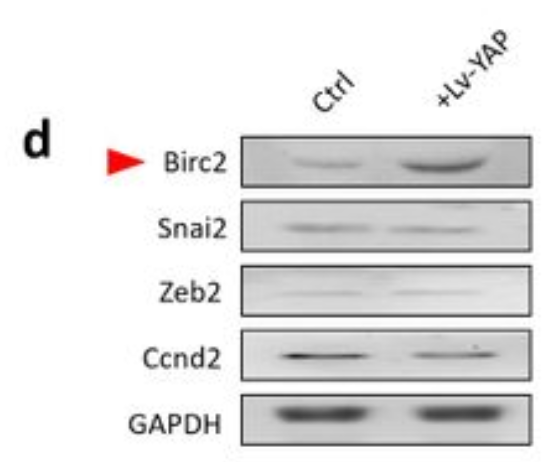ZEB2 Antibody - #AF5278
製品説明
*The optimal dilutions should be determined by the end user.
*Tips:
WB: For western blot detection of denatured protein samples. IHC: For immunohistochemical detection of paraffin sections (IHC-p) or frozen sections (IHC-f) of tissue samples. IF/ICC: For immunofluorescence detection of cell samples. ELISA(peptide): For ELISA detection of antigenic peptide.
引用形式: Affinity Biosciences Cat# AF5278, RRID:AB_2837764.
折りたたみ/展開
FLJ42816; HSPC082; KIAA0569; SIP 1; SIP1; Smad-interacting protein 1; SMADIP 1; SMADIP1; ZEB 2; Zeb2; ZEB2_HUMAN; Zfhx1b; ZFHX1B protein; Zfx1b; Zinc finger E box binding protein 2; Zinc finger E-box-binding homeobox 2; Zinc finger homeobox 1b; zinc finger homeobox protein 1; Zinc finger homeobox protein 1b;
免疫原
A synthesized peptide derived from human ZEB2, corresponding to a region within N-terminal amino acids.
- O60315 ZEB2_HUMAN:
- Protein BLAST With
- NCBI/
- ExPASy/
- Uniprot
MKQPIMADGPRCKRRKQANPRRKNVVNYDNVVDTGSETDEEDKLHIAEDDGIANPLDQETSPASVPNHESSPHVSQALLPREEEEDEIREGGVEHPWHNNEILQASVDGPEEMKEDYDTMGPEATIQTAINNGTVKNANCTSDFEEYFAKRKLEERDGHAVSIEEYLQRSDTAIIYPEAPEELSRLGTPEANGQEENDLPPGTPDAFAQLLTCPYCDRGYKRLTSLKEHIKYRHEKNEENFSCPLCSYTFAYRTQLERHMVTHKPGTDQHQMLTQGAGNRKFKCTECGKAFKYKHHLKEHLRIHSGEKPYECPNCKKRFSHSGSYSSHISSKKCIGLISVNGRMRNNIKTGSSPNSVSSSPTNSAITQLRNKLENGKPLSMSEQTGLLKIKTEPLDFNDYKVLMATHGFSGTSPFMNGGLGATSPLGVHPSAQSPMQHLGVGMEAPLLGFPTMNSNLSEVQKVLQIVDNTVSRQKMDCKAEEISKLKGYHMKDPCSQPEEQGVTSPNIPPVGLPVVSHNGATKSIIDYTLEKVNEAKACLQSLTTDSRRQISNIKKEKLRTLIDLVTDDKMIENHNISTPFSCQFCKESFPGPIPLHQHERYLCKMNEEIKAVLQPHENIVPNKAGVFVDNKALLLSSVLSEKGMTSPINPYKDHMSVLKAYYAMNMEPNSDELLKISIAVGLPQEFVKEWFEQRKVYQYSNSRSPSLERSSKPLAPNSNPPTKDSLLPRSPVKPMDSITSPSIAELHNSVTNCDPPLRLTKPSHFTNIKPVEKLDHSRSNTPSPLNLSSTSSKNSHSSSYTPNSFSSEELQAEPLDLSLPKQMKEPKSIIATKNKTKASSISLDHNSVSSSSENSDEPLNLTFIKKEFSNSNNLDNKSTNPVFSMNPFSAKPLYTALPPQSAFPPATFMPPVQTSIPGLRPYPGLDQMSFLPHMAYTYPTGAATFADMQQRRKYQRKQGFQGELLDGAQDYMSGLDDMTDSDSCLSRKKIKKTESGMYACDLCDKTFQKSSSLLRHKYEHTGKRPHQCQICKKAFKHKHHLIEHSRLHSGEKPYQCDKCGKRFSHSGSYSQHMNHRYSYCKREAEEREAAEREAREKGHLEPTELLMNRAYLQSITPQGYSDSEERESMPRDGESEKEHEKEGEDGYGKLGRQDGDEEFEEEEEESENKSMDTDPETIRDEEETGDHSMDDSSEDGKMETKSDHEEDNMEDGM
種類予測
Score>80(red) has high confidence and is suggested to be used for WB detection. *The prediction model is mainly based on the alignment of immunogen sequences, the results are for reference only, not as the basis of quality assurance.
High(score>80) Medium(80>score>50) Low(score<50) No confidence
研究背景
Transcriptional inhibitor that binds to DNA sequence 5'-CACCT-3' in different promoters. Represses transcription of E-cadherin.
Sumoylation on Lys-391 and Lys-866 is promoted by the E3 SUMO-protein ligase CBX4, and impairs interaction with CTBP1 and transcription repression activity.
Nucleus.
Belongs to the delta-EF1/ZFH-1 C2H2-type zinc-finger family.
研究領域
· Human Diseases > Cancers: Overview > MicroRNAs in cancer.
参考文献
Application: WB Species: human Sample: SW480 and HCT116 cells
Application: WB Species: Human Sample: KKU-452 cells
Application: WB Species: human Sample: EECs
Application: WB Species: mouse Sample: MPC5 cells
Application: WB Species: Human Sample: CSPCs
Restrictive clause
Affinity Biosciences tests all products strictly. Citations are provided as a resource for additional applications that have not been validated by Affinity Biosciences. Please choose the appropriate format for each application and consult Materials and Methods sections for additional details about the use of any product in these publications.
For Research Use Only.
Not for use in diagnostic or therapeutic procedures. Not for resale. Not for distribution without written consent. Affinity Biosciences will not be held responsible for patent infringement or other violations that may occur with the use of our products. Affinity Biosciences, Affinity Biosciences Logo and all other trademarks are the property of Affinity Biosciences LTD.






